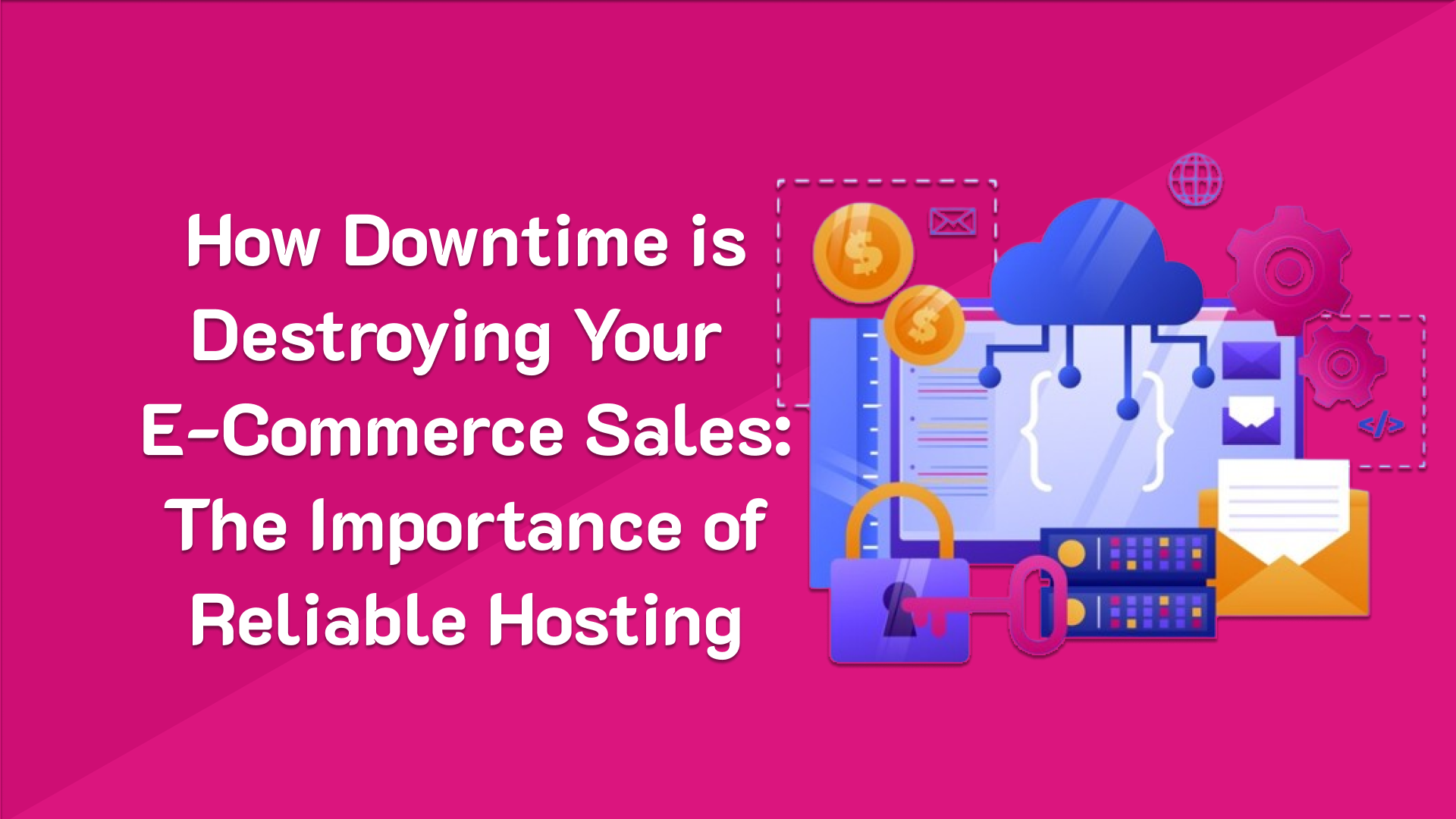
How Downtime is Destroying Your E-Commerce Sales (and How to Stop It)
TL;DR
- Website downtime leads to significant losses including lost sales, damaged reputation, lost traffic, and lower SEO rankings because customers expect reliable site availability. Even an hour of downtime can cost thousands to medium businesses.
- Choosing the right hosting solution is critical; cheap shared hosting often causes slow speed and more frequent downtime due to shared resources, whereas VPS or dedicated hosting offers better performance and reliability.
- Website speed directly influences Google ranking; slow sites caused by unreliable hosting get lower visibility, traffic, and sales.
- Business website optimization, including fast load times and scalable hosting solutions, is essential to enhance user experience and conversion rates.
- Small businesses face higher stakes from downtime since every lost customer to competitors can be critical; VPS hosting offers a balanced, affordable performance upgrade from shared hosting.
- Investing in reliable hosting is a strategic move to prevent downtime impacts, improve customer experience, and significantly boost e-commerce sales in a competitive market.
I’ve been in the web hosting industry for over a decade, and I’ve seen a lot. But one thing that consistently shocks e-commerce owners is the silent, devastating impact of website downtime. You spend months, maybe even years, building your brand, curating products, and driving traffic, only to have it all undone in a few minutes when your site goes offline. It’s like locking the doors to your brick-and-mortar store during the busiest shopping hour of the day.
The reality is, every second your e-commerce site is down, you’re not just losing a sale; you’re losing customer trust, damaging your brand reputation, and sabotaging your SEO efforts. The financial toll can be staggering, but the long-term consequences are often far worse. Many business owners I talk to don’t realize the full extent of the damage until it’s too late.
This isn’t just about a temporary technical glitch. It’s about the foundation of your online business. In this guide, I’ll walk you through exactly how downtime impacts your sales, how to calculate the real cost to your business, and most importantly, what you can do to prevent it. We’ll explore the common culprits, the hidden risks, and the practical steps you can take to ensure your online store remains open for business, 24/7.
What Is Website Downtime and Why Does It Happen?
Website downtime is any period when your website is inaccessible to users. When someone types in your URL or clicks a link, instead of your beautiful storefront, they get an error message like “This site can’t be reached” or a blank white screen. For an e-commerce business, this is the digital equivalent of a power outage.
After working with thousands of online stores, I’ve seen that downtime is rarely a random event. It’s almost always a symptom of an underlying issue that could have been prevented.
Common causes of website downtime
Let’s break down the usual suspects behind these frustrating outages. Understanding them is the first step toward building a more resilient online store.
Server overload, DNS issues, and hosting failures
These are the three horsemen of the website apocalypse. Here’s a quick rundown of what they mean for you:
- Server Overload: Your website “lives” on a server. This server has a finite amount of resources, like CPU and RAM. When you get a sudden surge in traffic—say, from a viral social media post or a Black Friday sale—it can overwhelm the server. It tries to serve too many requests at once, and like a juggler with too many balls, it drops everything. Your site crashes. This is especially common with cheap, shared hosting plans that aren’t equipped for e-commerce traffic.
- DNS Issues: The Domain Name System (DNS) is like the internet’s phonebook. It translates your human-friendly domain name (like
yourstore.com) into a machine-readable IP address. If your DNS records are misconfigured, or if the DNS provider has an outage, the internet can’t find your site. It’s like your store has been erased from the map. - Hosting Failures: This is the big one. Your hosting provider is responsible for the physical server and the network it runs on. Failures can happen for many reasons: hardware malfunctions (a hard drive dies), software crashes, or even physical events like a fire in the data center. A reliable host has multiple layers of redundancy to prevent this, but not all providers are created equal.
The hidden risks of unreliable hosting
When you choose a hosting provider, you’re not just buying server space; you’re entrusting them with your business’s uptime. An unreliable host introduces risks you might not have considered:
- Poor Security: Cheap hosting often comes with weak security measures, making your site a prime target for hackers who can take it down with DDoS attacks or malware.
- Lack of Support: When your site goes down at 3 AM, you need immediate help. Unreliable hosts often have slow, outsourced support that can’t resolve issues quickly, leaving you offline for hours.
- No Uptime Guarantee: Reputable hosts back their services with a Service Level Agreement (SLA) that guarantees a certain percentage of uptime (like 99.9%). If they fail, they compensate you. A provider without a strong uptime guarantee is a major red flag.
How Downtime Impacts E-Commerce Sales and Customer Trust
The immediate impact of downtime is obvious: if customers can’t access your site, they can’t buy anything. But the damage runs much deeper and continues long after your site is back online.

Lost revenue from missed transactions
Every minute of downtime is a minute you’re not making sales. This is a direct, measurable loss. If your store typically generates $1,000 per hour, an hour of downtime costs you exactly that. But it’s not just the sales you miss during the outage. A customer who intended to buy from you might go to a competitor and never return.
Increased cart abandonment rates
Imagine a customer has spent 20 minutes browsing your store, carefully selecting products, and finally proceeds to checkout. They enter their payment details, hit “Complete Purchase,” and… the site crashes. What do you think they’ll do? They’re not going to wait around. They’ll abandon their cart, and their frustration might be so high that they never attempt to purchase from you again. This experience shatters trust at the most critical moment of the customer journey.
SEO penalties and traffic loss
Search engines like Google prioritize a good user experience. When Google’s crawlers repeatedly try to access your site and find it unavailable, it sends a strong negative signal. They’ll assume your site is unreliable and start to lower its ranking in search results. A significant period of downtime can undo years of hard work you’ve put into your SEO. This means less organic traffic and, consequently, fewer potential customers finding your store in the first place.
How Much Does Website Downtime Really Cost Your Business?
Many e-commerce managers underestimate the financial impact of downtime because they only think about the immediate lost sales. To get a clear picture, you need to look at both the direct costs and the intangible, long-term brand damage.
Calculating downtime costs per hour
Here’s a simple formula to estimate your hourly cost of downtime. You’ll need a few numbers from your analytics:
- Average Hourly Revenue:
(Total Revenue / Number of Days) / 24 - Hourly Cost of Downtime:
Average Hourly Revenue
Let’s say your store makes $500,000 per year.
$500,000 / 365 days = $1,369.86per day$1,369.86 / 24 hours = $57.08per hour
So, a single hour of downtime costs you nearly $60 in lost revenue alone. For larger businesses, this number can quickly climb into the thousands. This formula doesn’t even account for the cost of paid ad campaigns sending traffic to a dead site or the salaries of employees trying to fix the problem.
Real-world case studies and data insights
You don’t have to take my word for it. The data is clear:
- A 2017 study found that Amazon lost an estimated $99 million in sales during its 40-minute Prime Day outage.
- Gartner estimates the average cost of IT downtime is $5,600 per minute, which extrapolates to well over $300,000 per hour.
- Even a one-second delay in page load time can lead to a 7% reduction in conversions. Downtime is the ultimate page load delay.
These numbers illustrate that no business, big or small, is immune to the financial sting of downtime.
The long-term brand damage of poor uptime
This is the cost that doesn’t show up on a spreadsheet but can be the most destructive. A single bad experience can turn a customer away for good. Research shows that 88% of online consumers are less likely to return to a site after a bad experience.
Every time your site is down, you’re eroding the trust you’ve built with your audience. They start to see your brand as unreliable and unprofessional. This damage can take years to repair and may require significant investment in rebranding and marketing campaigns to win back customer confidence.
How to Prevent Downtime and Keep Your E-Commerce Store Running Smoothly
The good news is that most downtime is preventable. With a proactive approach and the right infrastructure, you can protect your revenue and reputation.
Choosing reliable hosting with uptime guarantees
This is the single most important decision you can make for your e-commerce business. Don’t cheap out on hosting. Look for a managed hosting provider that specializes in e-commerce and offers a clear uptime guarantee. A 99.9% uptime guarantee might sound impressive, but it still allows for over 8 hours of downtime per year. Aim for 99.95% or higher.
Monitoring tools for real-time alerts
You can’t fix a problem you don’t know about. Implement uptime monitoring tools that check your website from multiple locations around the world every minute. If your site goes down, you’ll receive an instant alert via email, SMS, or Slack. This allows you and your technical team to start troubleshooting immediately, minimizing the duration of the outage.
Implementing CDN and redundancy strategies
A Content Delivery Network (CDN) stores copies of your site’s static assets (like images and CSS files) on servers around the world. When a customer visits your site, these assets are served from the location closest to them, which speeds up load times and reduces the load on your main server.
Redundancy is about having backups. This can mean having a failover server that automatically takes over if your primary server fails, or using load balancers to distribute traffic across multiple servers to prevent overload.
How Reliable Hosting Improves Conversion Rates and SEO
Investing in high-quality hosting isn’t just a defensive move to prevent downtime; it’s an offensive strategy that directly boosts your bottom line.
Faster load times and better user experience
Reliable hosting providers use high-performance hardware, like NVMe SSDs and powerful processors, which dramatically improves your site’s loading speed. A faster website provides a better user experience, which keeps customers engaged and encourages them to browse longer and buy more. As mentioned, even small improvements in speed can have a significant impact on your conversion rate.
Trust signals for returning customers
A website that is always available and performs flawlessly sends a powerful message to customers: “We are a professional, trustworthy business.” This builds confidence and encourages repeat purchases. Customers who know they can rely on your site are more likely to become loyal brand advocates.
The link between uptime and higher Google rankings
Google has explicitly stated that site speed and uptime are ranking factors. A fast, reliable website is seen as a high-quality site. By ensuring excellent uptime and performance, you are actively improving your SEO and making it more likely that new customers will discover you through organic search.
Why Skynethosting.net Is the Smart Choice for E-Commerce Businesses
After two decades in this business, I know what it takes to keep an e-commerce site online and thriving. At Skynethosting.net, we’ve built our entire infrastructure around the needs of online stores.
99.9% uptime guarantee with global data centers
We stand by our performance with a rock-solid 99.9% uptime guarantee. Our global network of data centers means your site is hosted closer to your customers, ensuring fast load times no matter where they are. This distributed infrastructure also provides a layer of redundancy that protects you from localized outages.
High-speed VPS and dedicated servers for peak traffic
Our high-speed Virtual Private Servers (VPS) and dedicated servers are built to handle the traffic spikes that are common in e-commerce. Whether you’re running a flash sale or getting featured on a major publication, our servers have the resources to keep your site online and responsive. We use the latest hardware, including NVMe drives that are up to 900% faster than traditional drives.
24/7 monitoring and instant technical support
Our expert team monitors our servers 24/7/365. We often detect and fix potential issues before they can even affect your site. And if you ever need help, our friendly, US-based support team is available around the clock to provide instant assistance. You’re not just a ticket number to us; you’re a partner.
Stop Downtime Before It Stops Your Sales

Let’s bring it all together. Website downtime isn’t just a minor inconvenience; it’s a direct threat to your e-commerce business’s survival. Every outage costs you lost sales, drives away potential customers, damages your brand’s reputation, and hurts your search engine rankings. The financial impact, both immediate and long-term, can be crippling.
Investing in a premium, managed hosting solution is one of the smartest business decisions you can make. It’s an insurance policy for your revenue stream, ensuring your store is always open, providing a superior experience for your customers, and giving you a competitive edge.
Don’t wait for the next outage to take action. Protect your sales, your customers, and your brand’s future. Switch to Skynethosting.net today and experience the peace of mind that comes with a hosting provider you can truly trust.
FAQs
What is e-commerce downtime?
E-commerce downtime refers to periods when your online store is inaccessible or non-functional due to server issues, maintenance, or unexpected failures. This can lead to lost sales, reduced customer trust, and a negative brand reputation.
How does downtime affect sales?
Every second of downtime means potential customers can’t browse or purchase products. This results in lost revenue, abandoned carts, and missed opportunities, especially during peak shopping times like holidays or sales events.
What causes e-commerce downtime?
Common causes include server overload, poor hosting, cyberattacks, software bugs, and inadequate maintenance. Identifying and addressing these issues proactively can help minimize disruptions and protect your business.
How can downtime damage customer trust?
Frequent downtime frustrates customers, making them question your store’s reliability. If they can’t access your site when needed, they may turn to competitors, leading to long-term trust and loyalty issues.
What is the financial impact of downtime?
Downtime costs vary but can range from hundreds to thousands of dollars per hour, depending on your store’s size and traffic. Beyond direct losses, it also impacts future sales and customer retention.
How can reliable hosting prevent downtime?
Reliable hosting ensures your site remains accessible with robust servers, regular backups, and 24/7 support. Investing in a quality hosting provider reduces the risk of unexpected outages and keeps your store running smoothly.
What are the signs of poor hosting?
Slow loading times, frequent outages, and lack of customer support are key indicators. If your hosting provider can’t handle your site’s traffic or growth, it’s time to consider upgrading.
How can I prepare for unexpected downtime?
Have a disaster recovery plan, including regular backups, monitoring tools, and a reliable hosting provider. Quick response and communication with customers during outages can also help mitigate damage.
What tools can help monitor downtime?
Tools like UptimeRobot, Pingdom, and StatusCake monitor your site’s performance and alert you to issues in real-time. These tools help you address problems before they escalate.
How often should I review my hosting plan?
Review your hosting plan annually or whenever you experience growth in traffic or sales. Upgrading to a more robust plan ensures your site can handle increased demand without compromising performance.



